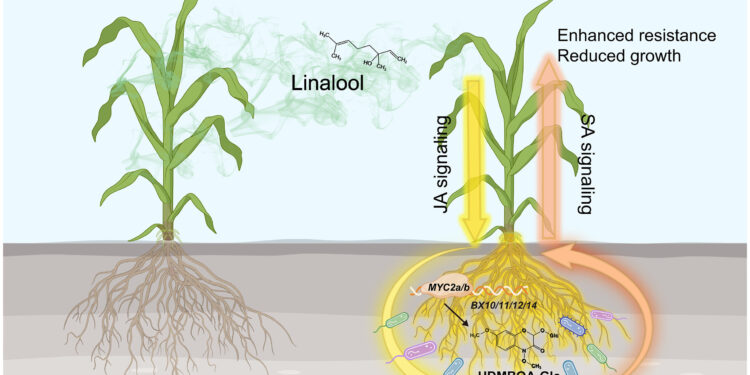Model illustrating how dense plantation triggers plant feedback to improve corn resistance. Credit: Science (2025). DOI: 10.1126 / Science.ADV6675
When corn fields become too congested, plants are informed to increase their defenses. A research team led by Dongsheng Guo of the University of Zhejiang revealed that under congested conditions, corn factories release a volatile gas called Linalool in the air. When it reaches neighboring plants, gas triggers a defensive response in their roots.
Although the planting of close crops can increase the size of the harvest, it also increases the risk of pathogens and parasites such as caterpillars and the agricultural corn. When this happens, corn crops do not remain lazy. We already knew that plants could change their shape in overcrowded conditions, such as greater growth to get more sun, but less was known on their immune response.
The research team reports that in dense fields, Linalool acts as an alarm bell, triggering the roots of neighboring plants to increase the production of jasmonate and other vegetable hormones. This, in turn, led to more than benzoxazinoids that flee in the ground around the roots.
This class of chemical defense compounds of plants modifies the bacterial composition of the soil, thus protecting the plants from pests. And the protective response is rapid, with increased defense against the caterpillars observed after only three days of growth in high density conditions.
However, as researchers note it of their studies in the field, there is a catch. This defensive increase is made at the cost of reducing growth, because plants put more of their defense resources rather than growth.
Scientists have also shown that the soil modified by densely planted corn crops offered continuous protection for new cultures, even against different parasites. Subsequent plantations were protected from nematodes and other pathogens, not only insects. This suggests that preparation for the defense of corn persists in the soil long after the harvesting of initial culture.
Nourish the world
Research has a clear advantage for the future of agriculture, as researchers say in their article, which was published in the journal Science. “Useing this natural defense through breeding, microbial inoculants or synthetic biology could allow the development of more resilient crops and requires fewer chemical entries.”
Corn is a staple in the diet of millions around the world, so understanding its defensive mechanisms is of great importance. The broader involvement of this research is that it could help to take up the challenge of feeding a growing world population while minimizing the use of pesticides and its associated environmental impact.
A research point of view article was also published in Science.
Written for you by our author Paul Arnold, published by Gaby Clark, and verified and revised by Robert Egan – This article is the result of meticulous human work. We are counting on readers like you to keep independent scientific journalism alive. If this report matters to you, please consider a donation (especially monthly). You will get a without advertising count as a thank you.
More information:
Dongsheng Guo et al, the feedback of ground plants triggered by Linalool leads to a defense adaptation in dense corn plantations, Science (2025). DOI: 10.1126 / Science.ADV6675
Niklas Schandry et al, the smell of a crowd, Science (2025). Doi: 10.1126 / Science.Adz7633
© 2025 Science X Network
Quote: Corn factories use a volatile gas to fight pests in densely congested fields (2025, August 19) recovered on August 20, 2025 from
This document is subject to copyright. In addition to any fair program for private or research purposes, no part can be reproduced without written authorization. The content is provided only for information purposes.



